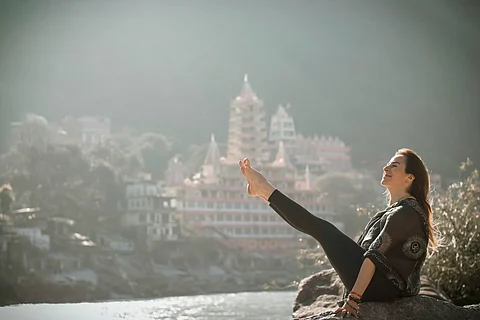
- Destinations
- Experiences
- Stay
- What's new
- Celebrating People
- Responsible Tourism
- CampaignsCampaigns
- SubscribeSubscribe
- Buy Now

International Yoga Day is celebrated annually on June 21. It promotes the benefits of the ancient Indian practice for physical and mental wellbeing. The United Nations established it in 2014, following a proposal by India's Prime Minister Narendra Modi.
This year’s theme, “Yoga for One Earth, One Health,” signifies that personal wellness and planetary health are inseparably linked. Detailing the theme, the United Nations (UN) said on their website, “Yoga strengthens the body, calms the mind and fosters a heightened sense of awareness and responsibility in daily life. This mindfulness allows one to choose healthier and more sustainable lifestyles. In caring for ourselves, we begin to care for the Earth, reflecting the enduring Indian ethos of ‘Vasudhaiva Kutumbakam’ —‘the world is one family.’”
In this story, we explain the origins of yoga and why Rishikesh, among all other Indian cities, is known as “the yoga capital of the world.”
Yoga is a philosophical tradition of physical, mental and spiritual practices that are aimed at controlling the body and mind to attain various salvation goals. Yoga-like practices are mentioned in the “Rigveda” and a number of early “Upanishads”, but systematic yoga concepts emerged during the fifth and sixth centuries BCE in ancient India's ascetic and śramaṇa movements, including Jainism and Buddhism.
Indian philosopher and monk Swami Vivekananda was the first Hindu teacher to advocate and disseminate elements of yoga to a Western audience during his tour of Europe and the United States in the 1890s. The receptivity of these audiences towards mysticism and the union between the spiritual and physical realms further cemented yoga’s popularity over the decades.
Today, yoga is part of most people’s fitness and wellness routines. A typical session combines pranayamas (breath-controlled exercises) and asanas (yoga postures), which end with savasana (a resting period). The appeal of Iyengar Yoga, Bikram Yoga and other yogic schools means the practice is now a multi-billion-dollar business involving classes, teacher certification, clothing, books, videos, equipment and retreats.
In 2016, yoga was listed by UNESCO as an intangible cultural heritage. Various studies have found that yoga practice leads to a wealth of improved health outcomes, including a more positive body image, mindfulness, a better relationship with food, enhanced fitness due to an increase in strength, flexibility and cardiovascular fitness, stress relief, and lower back pain.
The pilgrimage town of Rishikesh in Uttarakhand lies on the banks of the Ganges, a holy river in Hinduism. Legends say that the Hindu deity Rama did his penance here for killing the demon king, Ravana. The scenic vistas and numerous temples and ashrams here make it one of the top spiritual centres of India.
Due to its mentions in sacred Hindu texts and scriptures as a place of meditation and spiritual retreat, Rishikesh quickly became known as “the birthplace of yoga,” though verifiable sources are hard to find.
The city rose to worldwide fame when the English rock band The Beatles visited Maharishi Mahesh Yogi's ashram in 1968. They learnt Transcendental Meditation, changing Western attitudes about Indian spirituality in the process and encouraging the study of TM. The visit was also the most productive period for The Beatles' songwriting output, with many songs composed in Rishikesh ending up on their “White Album.” Today, the Beatles Ashram is a popular attraction for visitors to the town.
Besides yoga, Rishikesh is a hotspot for adventure enthusiasts, too. River rafting, bungee jumping, kayaking and cliff jumping are just some of the top thrills that attract millions of domestic visitors every year.
If you’re curious about booking a yoga retreat in Rishikesh, here’s where you should go:
Parmath Niketan: This is the biggest ashram in Rishikesh with 1,000 rooms on its sprawling eight acre campus. The site offers daily yoga, meditation and satsang activities as well as its world-renowned Ganga Aarti at sunset. There are also Ayurvedic treatment facilities and a charitable clinic/dispensary on the premises.
Swami Dayananda Ashram: Established during the 1960s by Swami Dayananda Saraswati, a renowned teacher of Vedanta, this ashram conducts courses on the “Bhagavad Gita” and the “Upanishads.” Visiting teachers guide Iyengar and Hatha yoga retreats that are suitable for beginners and intermediate students.
Phoot Chatti Yoga Ashram: This ashram is renowned for its seven-day yoga and meditation program. The teachings focus on the full spectrum of the yogic path and ashram life, not just asanas. Students will get to experience meditation, pranayama, cleansing, chanting, mauna (silence), puja (worship), kirtan (sacred singing) and other important aspects of the yogic path.
Rishikesh Yogpeeth: One of the main draws at Rishikesh Yogpeeth is its special setting, which provides the opportunity to experience yoga with nature. There are plenty of yoga teacher training courses as well as seven-day retreats for visitors to avail of. Accommodations consist of 18 well-appointed cottages for either single or twin occupancy.
Sattva Yoga Academy: With roots in the Vedanta and tantric traditions, the Sattva Yoga Academy offers 200-hour, 300-hour, and 500-hour yoga teacher training programs. Those on holiday can avail of their Panchakarma Detox package (7-21 days), the six-day Kirtan Retreat and Training and the Rasa Ayur Cleanse (3-14 days).
